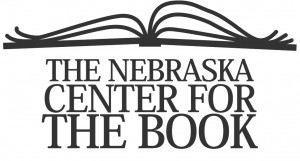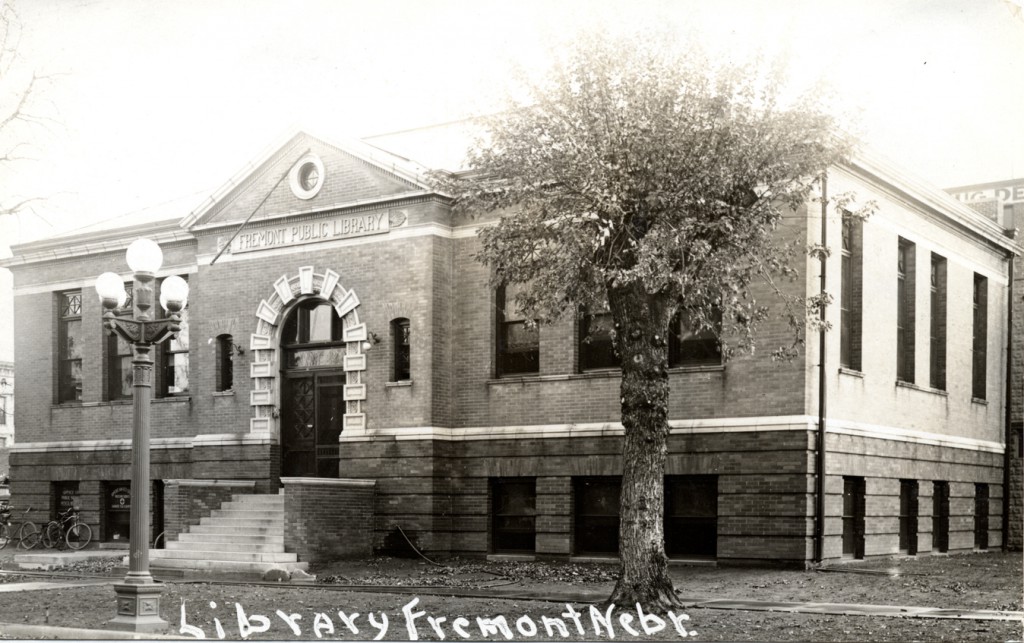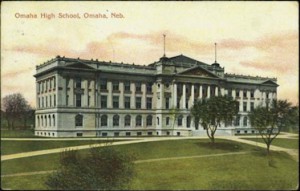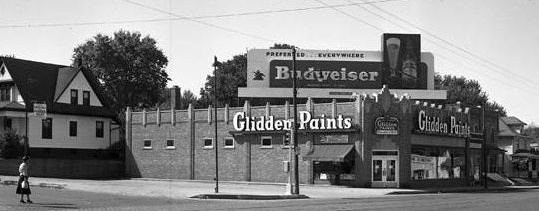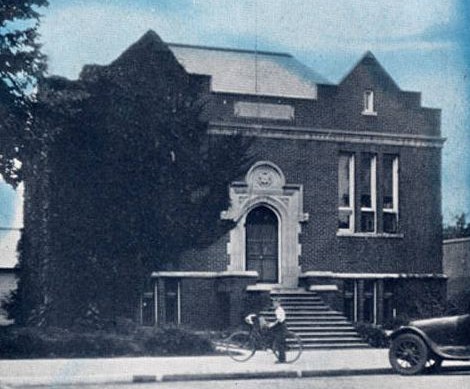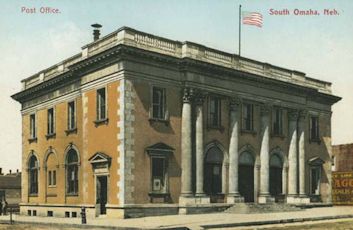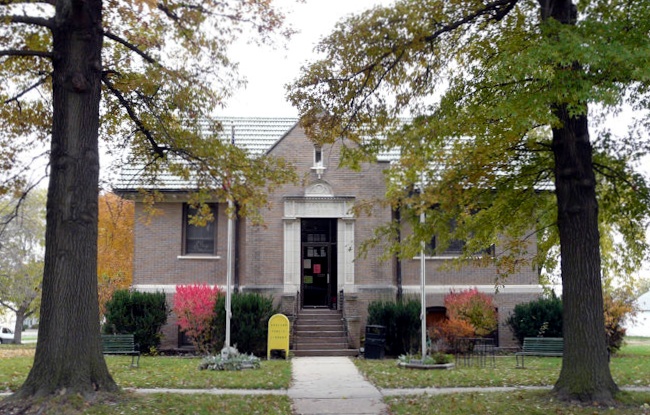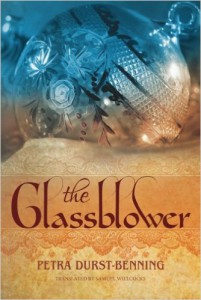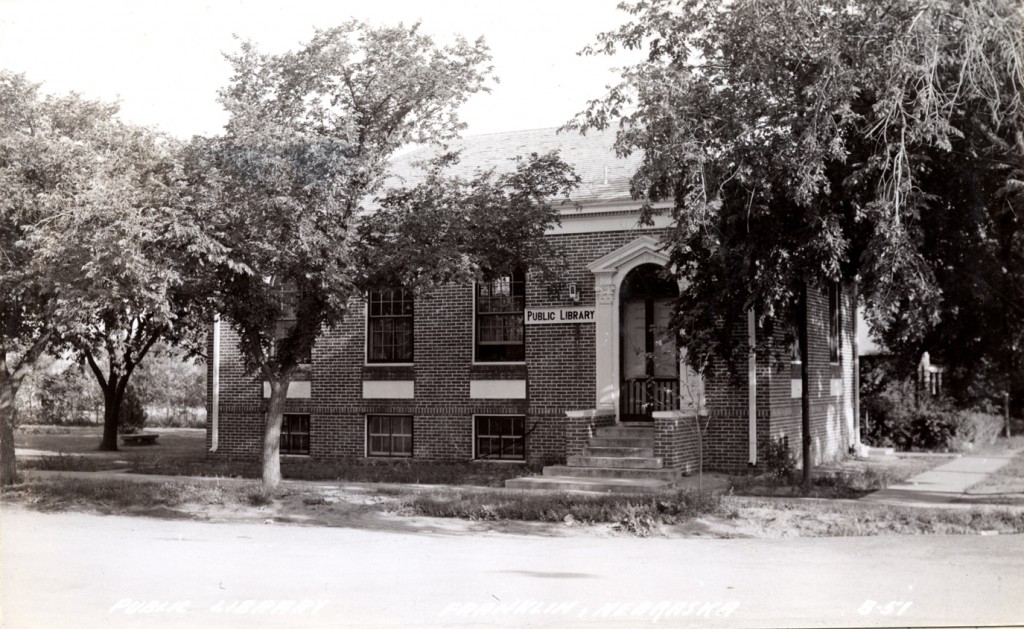Search the Blog
Categories
- Books & Reading
- Broadband Buzz
- Census
- Education & Training
- Friday Reads
- General
- Grants
- Information Resources
- Library Management
- Nebraska Center for the Book
- Nebraska Libraries on the Web
- Nebraska Memories
- Now hiring @ your library
- Preservation
- Pretty Sweet Tech
- Programming
- Public Library Boards of Trustees
- Public Relations
- Talking Book & Braille Service (TBBS)
- Technology
- Uncategorized
- What's Up Doc / Govdocs
- Youth Services
Archives
Subscribe
Monthly Archives: September 2015
The Data Dude on Social Media – Pt. 2
 After last week’s post, which admittedly was thrown together at the last minute in order to meet the one post a week deadline (yes, I’m playing a self-inflicted weekly match-it game with Lori Sailors), the Dude got to thinking more about libraries and social media. If you look at the library markers on the public library maps from the NLC website, there are links to selected social media sites for each library (e.g. Facebook, Twitter, and Flickr). The bar chart to the right uses the data from the map, showing the distribution of social media sites used by Nebraska libraries. The data comes from the NLC supplemental survey, and after looking at the supplemental survey, some revision might be in order. How many of you have active Delicious accounts? LibraryThing? These are both options on the supplemental survey but not Pinterest or Instagram. Well, perhaps we will work to revise the supplemental survey so that these might be options. Are there others? If so, let me know.
After last week’s post, which admittedly was thrown together at the last minute in order to meet the one post a week deadline (yes, I’m playing a self-inflicted weekly match-it game with Lori Sailors), the Dude got to thinking more about libraries and social media. If you look at the library markers on the public library maps from the NLC website, there are links to selected social media sites for each library (e.g. Facebook, Twitter, and Flickr). The bar chart to the right uses the data from the map, showing the distribution of social media sites used by Nebraska libraries. The data comes from the NLC supplemental survey, and after looking at the supplemental survey, some revision might be in order. How many of you have active Delicious accounts? LibraryThing? These are both options on the supplemental survey but not Pinterest or Instagram. Well, perhaps we will work to revise the supplemental survey so that these might be options. Are there others? If so, let me know.
Now, as the chart illustrates, Facebook (or is it facebook?) is the dominant force here (if you don’t understand why, check out last week’s post (or just look at the bar chart) for a better understanding of the dominance of facebook. Perhaps you could also double check your marker on the aforementioned maps to make sure that they provide the correct link to your library’s social media pages. If they don’t, you can update that information via the supplemental survey. This can be done at any time, although reminders are sent around the time of the public library survey.
Arguably, what’s more important is keeping your social media sites updated. Having a twitter account and only tweeting once a year is neither worthwhile nor effective at getting your message out there. Which brings the Dude to the next point and that is what icon to use for these various sites. Facebook isn’t too difficult, anything with the lower case f on a blue background. Twitter, however is a bit trickier. Do you use the lower case t or one of the variations of the little birdy? Do we assume that everyone knows that the birdy represents twitter? For Pinterest, the cursive p will do, but should you choose the circle or square background? Flickr’s are a bit more complicated, with numerous blue and pink dots and various renderings of lower case fr’s. The Dude imagines that someday we will have throwback icons similar to that of baseball uniforms and soda packaging (if we don’t already). Shaka.
NCompass Live: 2015 One Book One Nebraska: Death Zones & Darling Spies
 Join us for next week’s NCompass Live, “2015 One Book One Nebraska: Death Zones & Darling Spies”, on Wednesday, Sept. 30, 10:00-11:00 am Central Time.
Join us for next week’s NCompass Live, “2015 One Book One Nebraska: Death Zones & Darling Spies”, on Wednesday, Sept. 30, 10:00-11:00 am Central Time.
In this eleventh year of One Book One Nebraska, Nebraska libraries and other  literary and cultural organizations continue to plan activities and events to encourage all Nebraskans to read and discuss the same book. Join us to hear more about this statewide reading promotion activity, sponsored by the Nebraska Library Commission, Humanities Nebraska, and the Nebraska Center for the Book.
literary and cultural organizations continue to plan activities and events to encourage all Nebraskans to read and discuss the same book. Join us to hear more about this statewide reading promotion activity, sponsored by the Nebraska Library Commission, Humanities Nebraska, and the Nebraska Center for the Book.
Nebraska Library Commission Director Rod Wagner and Nebraska Library Commission Communications Coordinator Mary Jo Ryan will be joined by special guests Ron and Lois Meyer, Nebraska Center for the Book. Join us to:
- Learn about how to create a successful local reading promotion using Nebraska’s year-long, statewide celebration featuring Death Zones & Darling Spies: Seven Years of Vietnam War Reporting, by Beverly Deepe Keever.
- Brainstorm strategies to read and discuss Death Zones & Darling Spies: Seven Years of Vietnam War Reporting, a nonfiction story in which Keever describes what it was like for a farm girl from Nebraska to find herself halfway around the world, trying to make sense of one of the nation’s bloodiest and bitterest wars.
- Find tools to help engage your community in local activities to encourage them to come together through literature to explore this nonfiction work in community-wide reading programs.
- Learn about the Celebration of Nebraska Books, set for Nov. 14, which will celebrate this book, along with the winners of the 2015 Nebraska Book Awards.
Upcoming NCompass Live events:
- Oct. 7 – STEAM @ Your Library
- Oct. 14 – NO NCOMPASS LIVE THIS WEEK – Enjoy the 2015 NLA/NSLA Annual Conference!
- Oct. 21 – Introducing Two New Library Guides
- Oct. 28 – The Golden Sower Award: Nebraska’s Children’s Choice Literary Award
For more information, to register for NCompass Live, or to listen to recordings of past events, go to the NCompass Live webpage.
NCompass Live is broadcast live every Wednesday from 10am – 11am Central Time. Convert to your time zone on the Official U.S. Time website. The show is presented online using the GoToWebinar online meeting service. Before you attend a session, please see the NLC Online Sessions webpage for detailed information about GoToWebinar, including system requirements, firewall permissions, and equipment requirements for computer speakers and microphones.
Posted in Books & Reading, Education & Training
Leave a comment
Friday Reads: Paul Theroux’s The Great Railway Bazaar
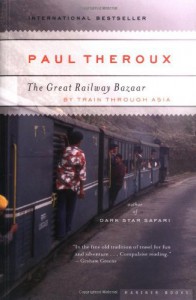 Why would a person be interested in reading a book published forty years ago? It doesn’t seem that is old enough to be considered a “classic,” and, to a degree, the author is not one of current list of “hot” authors that everyone wants to pick up. Still, there are often reasons to read a book not on a current best seller list that have less to do with the author, the subject, the title, the whatever. In this case it was a “waste not, want not” situation. I’d purchased this book over two years ago on a trip out of the country (It cost 187 “I-don’t-know-whats,”), I’d had it sitting around and had recently run across it again while winnowing my book collection to decide what to give to Lincoln City Libraries as donations.
Why would a person be interested in reading a book published forty years ago? It doesn’t seem that is old enough to be considered a “classic,” and, to a degree, the author is not one of current list of “hot” authors that everyone wants to pick up. Still, there are often reasons to read a book not on a current best seller list that have less to do with the author, the subject, the title, the whatever. In this case it was a “waste not, want not” situation. I’d purchased this book over two years ago on a trip out of the country (It cost 187 “I-don’t-know-whats,”), I’d had it sitting around and had recently run across it again while winnowing my book collection to decide what to give to Lincoln City Libraries as donations.
A little history here — I’ve always been interested in trains. Our first home (my twin sister’s and mine) was an apartment a couple of stories above the local public library in Emmaus, Pennsylvania, with the back “yard” a steep bank falling away to railroad tracks on which heavy rail cars clanked their way by. Our second home was an old place (Built in 1879 by A. & H. Hoerhammer) on Railroad Street, with those same railroad tracks now a narrow street and a less-steep bank away from our front door. So, you see, I couldn’t help but be, if not interested, at least steeped in the noise, smells, etc. first of steam locomotives, then diesel monsters as their rushed or crawled by our house.
But back to the book. The Great Railway Bazaar recounts author Theroux’s four-month journey, mostly by rail (with a few legs of the journey by ship and plane) all the way from Great Britain, to Japan and back. Most critics consider this book Theroux’s greatest achievement, but he has also written fiction — Jungle Lovers, Saint Jack, and perhaps more famous, The Mosquito Coast, several of these having been made into films.
If you choose to read this book, you will find the author highly entertaining (of the “laugh-out-loud” variety) at times. Other times he comes across as too critical of an entire culture (a little too much generalization at times), and at other points in the book very incisive. He doesn’t shrink from controversy and tackles just about anything, not excluding himself from criticism when he feels it is needed.
I do not doubt his sometimes shocking descriptions of life in a number of the countries he rides through. The most interesting feature of the book, however, is seeing how his descriptions of life on the various trains he takes reflect the countries and cultures they are riding through, and how he is affected by those forces. (“The railway bazaar, with its gadgets and passengers, represented the society so completely that to board it was to be challenged by the national character.”) But at other times the train travel itself, especially on journeys that lasted for days at a time, the author expresses his pleasure: “Train travel animated my imagination and usually gave me the solitude to order and write my thoughts. I travelled easily in two directions, along the level rails while Asia flashed changes at the window, and at the interior rim of a private world of memory and language.”
Of course, so many years later his descriptions are probably woefully out-of-date for a number of the countries he passed through, although I have to admit that some of them still appear quite incisive today. (For example, the Shah is still in power in Iran; the U.S. is just pulling out of the war in Vietnam. In Saigon a local woman tries to get the author to take a “half-American” baby with him. In Japan he experiences a noodle soup (“ra-men”) for the first time, probably one of the earliest mentions of that ubiquitous food in American writing.)
One of the most entertaining aspects of this book for me was that it dragged me decades back to my time as a not-very-good English major in college. The book is loaded with literary and historical allusions, making me want to go back to books I missed (or didn’t finish reading) all those years ago, and savor them with the passage of time and their relationship to this book. The author also captures the essence of really long-distance travel, especially to foreign countries when he says, “. . . the scenes changing in the train window from Victoria Station to Tokyo Central are nothing compared to the change in himself; and travel writing, which cannot but be droll at the outset, moves from journalism to fiction, arriving . . . at . . . autobiography.” And in this he is in good company with both Mark Twain and Henry James.
Try it. I think you’ll like it!
Richard Miller
The Data Dude on Social Media Use
 Today’s post will be a little blip about social media use. A recent Pew Research Center study took a look at gender and social media use and compared it to findings from previous years. While there once was a noticeable gender gap between men and women (with women being more likely than men to use social media), there is no longer such a noticeable difference. Does your library use social media? If so, what do you use and for what purpose? If you are interested in setting up social media sites or pages are you aware that there is help from the Nebraska Library Commission? If you’ve been meaning to do this but need some assistance, contact the NLC Technology and Innovation Librarian, Craig Lefteroff.
Today’s post will be a little blip about social media use. A recent Pew Research Center study took a look at gender and social media use and compared it to findings from previous years. While there once was a noticeable gender gap between men and women (with women being more likely than men to use social media), there is no longer such a noticeable difference. Does your library use social media? If so, what do you use and for what purpose? If you are interested in setting up social media sites or pages are you aware that there is help from the Nebraska Library Commission? If you’ve been meaning to do this but need some assistance, contact the NLC Technology and Innovation Librarian, Craig Lefteroff.
According to the Pew survey, there are some differences in the type of social media used by gender. As the chart indicates, Facebook, while still used more by women than men, remains the most frequently used site overall. Pinterest is dominated by women, and men are more likely to use discussion forums and slightly more likely to use Twitter. The point to this is to have a better understanding of the various social media options for your library, and to understand the benefits of using social media to reach your community. Of course, this is only the starting point in gathering data on the demographics of your local community. Another great source for information to help with setting up and maintaining a social media site is the Nebraska Libraries on the Web site and blog. Check it out and you might come away with a fresh new idea or two. Shaka.
Young Readers Invited to Write to Favorite Authors
FOR IMMEDIATE RELEASE:
September 22, 2015
FOR MORE INFORMATION:
Mary Jo Ryan
402-471-3434
800-307-2665
Young Readers Invited to Write to Favorite Authors
Young readers in grades 4-12 are invited to write a personal letter to an author for the Letters about Literature (LAL) contest, a national reading and writing promotion program. The letter can be to any author (living or dead) from any genre—fiction or nonfiction, contemporary or classic—explaining how that author’s work changed the student’s view of the world. The 23rd annual writing contest for young readers is made possible by a generous grant from the Dollar General Literacy Foundation, with additional support from gifts to the Center for the Book in the Library of Congress, which promotes the contest through its affiliate Centers for the Book, state libraries and other organizations. This reading and writing promotion is sponsored in Nebraska by the Nebraska Center for the Book and Nebraska Library Commission, and supported by Houchen Bindery Ltd. and Chapters Books in Seward.
Prizes will be awarded on both the state and national levels. The Nebraska Center for the Book’s panel of judges will select the top letter writers in the state, to be honored in a proclamation-signing ceremony at the state capitol during National Library Week in April 2016. Their winning letters will be placed in the Jane Pope Geske Heritage Room of Nebraska Authors at Bennett Martin Public Library in Lincoln. Nebraska winners will receive state prizes, and then advance to the national judging.
A panel of national judges for the Center for the Book in the Library of Congress will select one National Winner per competition level (Level I for grades 4-6, Level II for grades 7-8, and Level III for grades 9-12) to receive a $1,000 cash award, to be announced in May 2016. The judges will also select one National Honor winner on each competition level to receive a $200 cash award.
Teachers, librarians, and parents can download free teaching materials on reader response and reflective writing, along with contest details and entry forms, at www.read.gov/letters. Nebraska-specific information (including lists of Nebraska winners of past competitions) is available at http://centerforthebook.nebraska.gov/programs/LAL.html. Listen to Nebraska winners, Ashley Xiques and Sydney Kohl, read and talk about and their winning letters to authors that meant something to them in their own lives on NET Radio’s All About Books (http://netnebraska.org/basic-page/radio/all-about-books). Submissions from Grades 9-12 must be postmarked by December 4, 2015. Submissions from Grades 4-8 must be postmarked by January 11, 2016. For more information contact Mary Jo Ryan, 402-471-3434 or 800-307-2665.
The Nebraska Center for the Book is housed at the Nebraska Library Commission and brings together the state’s readers, writers, booksellers, librarians, publishers, printers, educators, and scholars to build the community of the book, supporting programs to celebrate and stimulate public interest in books, reading, and the written word. The Nebraska Center for the Book is supported by the Nebraska Library Commission.
As the state library agency, the Nebraska Library Commission is an advocate for the library and information needs of all Nebraskans. The mission of the Library Commission is statewide promotion, development, and coordination of library and information services, bringing
###
The most up-to-date news releases from the Nebraska Library Commission are always available on the Library Commission Website, http://nlc.nebraska.gov/publications/newsreleases.
Posted in Books & Reading, General, Youth Services
Leave a comment
NCompass Live: Who Done It? And Who Figured it Out? The NLC Booktalks Mysteries
 Join us for next week’s NCompass Live, “Who Done It? And Who Figured it Out? The NLC Booktalks Mysteries”, on Wednesday, Sept. 23, 10:00-11:00 am Central Time.
Join us for next week’s NCompass Live, “Who Done It? And Who Figured it Out? The NLC Booktalks Mysteries”, on Wednesday, Sept. 23, 10:00-11:00 am Central Time.
Books that fall within the mystery category take up a goodly share of the fiction shelf space in public libraries. It seems that sooner or later, most active readers read mysteries. Within the genre, there’s just about something for everyone – romantic mystery, historical mystery, cozy, hardboiled, detectives professional and non from all walks of life, and even some non-human – mysteries run the gamut. And the readers can’t get enough of their favorite detective series. Cecelia Ramsey, Devra Dragos, and Laura Johnson will talk about some of their favorite mysteries, about some of the challenges around providing mysteries in the library, and some of the tools that can help.
Upcoming NCompass Live events:
- Sept. 30 – NCompass Live: 2015 One Book One Nebraska: Death Zones & Darling Spies
- Oct. 14 – NO NCOMPASS LIVE THIS WEEK – Enjoy the 2015 NLA/NSLA Annual Conference!
- Oct. 21 – Introducing Two New Library Guides
- Oct. 28 – The Golden Sower Award: Nebraska’s Children’s Choice Literary Award
For more information, to register for NCompass Live, or to listen to recordings of past events, go to the NCompass Live webpage.
NCompass Live is broadcast live every Wednesday from 10am – 11am Central Time. Convert to your time zone on the Official U.S. Time website. The show is presented online using the GoToWebinar online meeting service. Before you attend a session, please see the NLC Online Sessions webpage for detailed information about GoToWebinar, including system requirements, firewall permissions, and equipment requirements for computer speakers and microphones.
Posted in Books & Reading, Education & Training
Leave a comment
Friday Reads: The Antidote by Oliver Burkeman
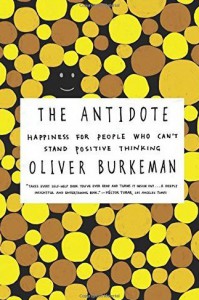 My original intention was to write a bit about the Wisdom of Insecurity, authored by Alan Watts and published in 1951. The reasons for this include the fact that I just recently read it, and Watts demonstrates a directness and clarity that is refreshing. The book reads like it could have been written today:
My original intention was to write a bit about the Wisdom of Insecurity, authored by Alan Watts and published in 1951. The reasons for this include the fact that I just recently read it, and Watts demonstrates a directness and clarity that is refreshing. The book reads like it could have been written today:
“Human beings appear to be happy just so long as they have a future to which they can look forward – whether it be a ‘good time’ tomorrow or an everlasting life beyond the grave. For various reasons, more and more people find it hard to believe in the latter. On the other hand, the former has the disadvantage that when this ‘good time’ arrives, it is difficult to enjoy it to the full without some promise of more to come. If happiness always depends on something expected in the future, we are chasing a will-o’-the-wisp that ever eludes our grasp, until the future, and ourselves, vanish in the abyss of death.”
And …
“For this stream of stimulants is designed to produce cravings for more and more of the same, through louder and faster, and these cravings drive us to do work which is of no interest save for the money it pays-to buy more lavish radios, sleeker automobiles, glossier magazines, and better television sets, all of which will somehow conspire to persuade us that happiness lies just around the corner if we will buy one more.”
Well, the appeal of Watts (described in many circles as playing a large role in bringing eastern philosophy to a western crowd) is not just in the one-liners. His writing appears to come at least somewhat from the perspective of the ever increasingly trendy “living in the moment” prescription, but also is perhaps at least a precursor to the deeper notions and variants of nondualistic pantheism. After reading Watts, it seemed fairly easy to sum these major points up; I was looking for something with a bit more depth. Oliver Burkeman’s the Antidote provides a little more of that. I say a little because much of what Burkeman writes about is quite similar to Watts, but there is some new material here that is worthwhile. Burkeman’s ideas might at least be a decent starting point.
Burkeman’s title provides some degree of a play on words (whether intended or not) in that the antidote he describes is something to counteract one’s unhappiness and the fact that he provides numerous anecdotes throughout the book. Burkeman draws from many sources, largely from the work of Stoicism and Albert Ellis and smally on things like the Museum of Failed Products, the self-help industry, Zen Buddhism, meditation, Mt. Everest climbers, Eckhart Tolle, and memento mori. Burkeman makes good arguments against the preoccupation with goals, less intensive planning, and ditching the modern day “cult of optimism.” Burkeman notes that “it is our constant efforts to eliminate the negative – insecurity, uncertainty, failure, or sadness – that is what causes us to feel so insecure, anxious, uncertain, or unhappy.”
It might be easy to conclude that Burkeman is advocating negative thinking. He’s not. There is a clear differentiation between negative thinking and the prescribed (stoic) rational thinking.
One perplexing notion, at least to me and requiring further thought and reflection is this aforementioned notion of “living in the moment”. It seems to me that consciousness plays a large role in it, and if a person is consciously thinking about something (including living in the moment), can they really be doing or experiencing it? If we perpetually read books, attend seminars, or participate in groups that bring this idea front and center, can we ever really achieve it under those circumstances? Probably not, and I think Watts would agree: “To understand music, you must listen to it. But so long as you are thinking, ‘I am listening to this music,’ you are not listening.” At any rate, if you are looking at an alternative to the positive thinking machine, the Antidote might prove to be a good read, and might turn you on to some other thought provoking stuff.
The Data Dude – Wednesday Watch: SOA and Silicon Valley
![]() Today’s Wednesday Watch will focus on a snippet (ok maybe a bit more than a snippet) of FX’s Sons of Anarchy (SOA), a show the Dude really wanted to like but abandoned in the middle of the final season (to be honest, it should have happened much earlier). After the SOA analysis, the post will then shift to a new show with high hopes that is thus far exceeding expectations, HBO’s Silicon Valley.
Today’s Wednesday Watch will focus on a snippet (ok maybe a bit more than a snippet) of FX’s Sons of Anarchy (SOA), a show the Dude really wanted to like but abandoned in the middle of the final season (to be honest, it should have happened much earlier). After the SOA analysis, the post will then shift to a new show with high hopes that is thus far exceeding expectations, HBO’s Silicon Valley.
First: The bad. Sons of Anarchy (various seasons) are part of the holdings of approximately 5 or 6 Nebraska public libraries, depending on the season. If your library is considering it, the Dude recommends that you put your money toward something else gangster-related (such as the Sopranos or the Wire), and spend the rest on Silicon Valley (see below). Yes, SOA does have some high points, generally during the first two seasons, and often centered on the witty one liners coming from Katey Sagal (Gemma) or Ron Perlman (Clay). The acting on the show is solid; however the low point is the unravelling of the show’s writing over time into the abyss of absurdity. SOA creator and writer Kurt Sutter has a response to the Dude’s criticism, namely that all the other non-haters “get it”, and we simply don’t. Well, that may be the case, but our disappointment comes from the fact that we believe the show could have been much better, if the unbelievable, irrational parts were sufficiently cleaned up. And it had potential. Without giving away too much, let’s dive in a bit as to why SOA misses the mark. The Dude started watching the show at the urging of various individuals, including some motorcycle aficionados. Now for the record, the Dude isn’t particularly interested in cycles (except for the human powered kind), but certainly has nothing against them. Not quite mid-way through the final season, the Dude had enough, and didn’t even have the desire to see how the show ended. Yes, it was that disappointing. Here are the reasons why.
Number one: The overuse of the musical montage. Works occasionally, but too much of even a good thing is well, a bad thing. Some of the music comes across as just plain tacky (e.g. changing the lyrics in “House of the Rising Sun” from “New Orleans” to “Charming Town” – the fictional town where SOA takes place) and at other times it’s just plain clichéd. As the series goes on, the musical montage gets more and more used and thus more and more annoying.
Number two: The prison scenes started out just OK, but became completely unbelievable over time. Well, it should be noted that they held a period of believability on a sensationalized, Hollywood version of what occurs behind bars. Even if we accept the fact that some of this stuff is a bit overblown, what writer Kurt Sutter’s character (Otto Delaney) is able to accomplish in prison is pretty comical when you think about it. All of it could never happen that way. The difficult part to swallow is that Sutter seems to have no problem serving it up on a platter with the manner of Anthony Hopkins in the Remains of the Day. The truth of the matter is that for most people who are either in prison or work there it is a mundane, repetitive, smelly, depressing, argumentative, limiting environment with small amounts of possessions and privacy that zaps one’s daily energy (inmates and staff). Admittedly, it is in fact an environment charged with violence, testosterone, manipulation, and sexuality, but to a much lesser degree than portrayed by Sutter.
Number three: The level of trust demonstrated by certain rival gang members that ultimately leads to their murder is off base. Some of these characters are hyped up as “major playas”, yet when they have a sit down with another gang and they roll in with only 2 or 3 of their crew and when they sometimes turn their backs on potential rivals, it ultimately leads to their predictable demise. It happens more than once, and it seems that guys of this caliber (if you believe the hype from the accompanying dialogue) would roll in on 3-4 tinted window Escalades or Suburbans, after setting up a few guys on the perimeter ahead of time, and toting no less than a few machine guns. And never, ever, turn their backs on anyone or exhibit any degree of trust. Furthermore, some of the alliances formed among the various thugs (under the circumstances) seem a bit perplexing or preposterous.
Number four: The kill count. Basically, the crew consists of about 8-9 guys, give or take throughout the series. True, the club has numerous other “charters” in different towns or cities, but the core group, SAMCRO (Sons of Anarchy Motorcycle Club, Redwood Original – the main charter) is generally around or less than 10 guys. The kill count for just the members over the 7 seasons is a whopping 144 (see chart). By comparison, the total deaths (including those not directly caused by Tony’s crew) in the Sopranos was 92. Some of these SOA kills are of the persuasion that they would most likely draw significant attention from not just local but national law enforcement.
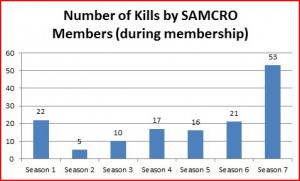 Number five: The continuity errors. This is a minor complaint, but part of a larger criticism related to editing as a whole. Every show has these types of errors and they sometimes are noticeable, sometimes not. On SOA, they seemed to be noticeable and distracting, and for a show of this caliber, it was unexpected. These include blood and tattoos that either disappear or change places from scene to scene, cars that change make and model from scene to scene, actors that have or wear items then don’t have them, etc. It’s a minor complaint, but a complaint nonetheless. Details matter.
Number five: The continuity errors. This is a minor complaint, but part of a larger criticism related to editing as a whole. Every show has these types of errors and they sometimes are noticeable, sometimes not. On SOA, they seemed to be noticeable and distracting, and for a show of this caliber, it was unexpected. These include blood and tattoos that either disappear or change places from scene to scene, cars that change make and model from scene to scene, actors that have or wear items then don’t have them, etc. It’s a minor complaint, but a complaint nonetheless. Details matter.
Now on to Silicon Valley. According to WorldCat, season 1 is held by just 2 Nebraska public libraries. The show follows main character Richard Hendriks (Thomas Middleditch) and his friends or colleagues (however you might see it) who all live together under one roof in a startup incubator in or near Palo Alto. Erlich Bachmann (played brilliantly by TJ Miller, and adequately filling the no-nonsense sharp witted gap left by the departure of Roger Sterling) lets Richard and his friends stay in his house rent free in exchange for a 10% stake in the projects they invent while living in the incubator. Richard develops a powerful search algorithm (Pied Piper) and the show follows the path from Pied Piper’s inception to startup, as well as the rest of the Silicon Valley world. Now, before someone mentions that there is a certain degree of unbelievability in Silicon Valley (see SOA criticism above), the difference is that Silicon Valley isn’t pretending to pass everything off this way (as SOA is with a straight face).
The show’s creator, Mike Judge (Beavis and butt-head, Office Space, King of the Hill) has previously worked at a Silicon Valley startup, and does a pretty good job of satirizing the culture. Although some, such as Elon Musk, are not quite as amused. Now for the record, the Dude is a Musk (and Tesla and Solar City) fan, although his frequently quoted response to Silicon Valley actually does more to prove that the HBO series hits, rather than misses the mark. Musk is quoted as saying:
“I really feel like Mike Judge has never been to Burning Man, which is Silicon Valley. If you haven’t been, you just don’t get it. You could take the craziest L.A. party and multiply it by a thousand, and it doesn’t even get … close to what’s in Silicon Valley. The show didn’t have any of that.” Judge didn’t bite when he responded to Musk’s comment, merely stating that: “I mean, he’s Elon Musk and he knows more about the tech world than I do, so I would never argue with that. But we’re doing a comedy. This isn’t a documentary.” In a way, Musk’s comment seems self-satirizing (read it again a few times and it will become more apparent). TJ Miller also had an apt response: “Yeah, but, and I’m not gonna name names, but if the billionaire power players don’t get the joke, it’s because they’re not comfortable being satirized, … And they don’t remember that to be a target of humor is an honor — you have to be venerated to be satirized. Like, I’m sorry, but you could tell everything was true. You guys do have bike meetings …”
For the record, perhaps Judge will think of a way to work Musk’s thoughts into a future episode, and I could go on about Burning Man and Silicon Valley, but it would be hard to beat this Burning Man spoof (complete with a great Petyr Baelish imitation). Shaka.
Posted in General, Library Management, Technology, Uncategorized
Leave a comment
Nebraska Then and Now
When looking at pictures of historical buildings in Nebraska Memories I’m always surprised at how many buildings and places I recognize. Many of these buildings have been around for 100 years and are still being used today. Over the years, as I’ve traveled across the state, I’ve tried to take pictures of some of these historical buildings because I thought it would be fun to see how much or how little these buildings have changed.
As I’ve taken pictures of these buildings there are a few things that I have noticed. First of all there is a lot less clutter in the historical photos. Today many of the pictures I’ve taken are full of stop lights, street signs, and electrical lines. Also it appears that we have planted a lot of trees over the past 100 or so years. I like trees. I think it’s great we have planted so many but it really makes it hard to take a picture of a building when it is surrounded by trees. The last thing I’ve noticed as I’ve looked at the old photos is angle from which the photos were taken from. The photographers were either able to stand further away from the buildings or they had access to a neighboring building and took the picture out the window or from the rooftop. Also you can only move so far back when you are standing on a street corner in downtown Omaha surrounded by tall buildings.
I hope you enjoy looking at these pictures to see how some of these buildings have and have not changed over the years. Click on an old picture to learn more about the building. Click on the new picture to see a larger version of the new picture.
Flat Iron Building – 17th, St. Mary’s, Howard, and 18th Streets, Omaha

Picture: 2015
Read about the recent renovations to this building.
Omaha Public Library – 19th and Harney Streets, Omaha
Little Building – 11th and O Streets, Lincoln
Omaha High School – 20th and Dodge St, Omaha
Mitchell High School – 19th Ave and 18th St, Mitchell
Exterior of Glidden Paints building – 31st and Leavenworth St, Omaha
Public Library, Schuyler, Nebr. – E 10th and C Streets, Schuyler
Post office, South Omaha, Neb. – S 24th and M Streets, Omaha
Donley Stahl Building – 13th and N Street, Lincoln
Carnegie Library, Ashland – N 15th and Boyd Streets, Ashland
Pavilion at Miller Park – Millier Park Drive, Omaha
Keeline Building – 17th & Harney Streets, Omaha
Sharp Building – 13th and N Street, Lincoln
Security Mutual Building – 12th and O Streets, Lincoln
First National Bank – 16th and Farnam Streets, Omaha
Visit Nebraska Memories to search for or browse through many more historical images digitized from photographs, negatives, postcards, maps, lantern slides, books and other materials.
Nebraska Memories is a cooperative project to digitize Nebraska-related historical and cultural heritage materials and make them available to researchers of all ages via the Internet. Nebraska Memories is brought to you by the Nebraska Library Commission. If your institution is interested in participating in Nebraska Memories, see http://nlc.nebraska.gov/nebraskamemories/participation.aspx for more information, contact Devra Dragos, Technology & Access Services Director.
Posted in General, Nebraska Memories, Technology
3 Comments
NCompass Live: Board in the Stacks: Developing a Board Game Collection for your Library
 Join us for next week’s NCompass Live, “Board in the Stacks: Developing a Board Game Collection for your Library”, on Wednesday, Sept. 16, 10:00-11:00 am Central Time.
Join us for next week’s NCompass Live, “Board in the Stacks: Developing a Board Game Collection for your Library”, on Wednesday, Sept. 16, 10:00-11:00 am Central Time.
There is currently a booming interest in board games and libraries are just beginning to discover the social, creative, recreational, and educational benefits for patrons. This webinar will provide practical advice for researching, acquiring, cataloging, and preparing a collection for circulation that will meet your community’s specific needs. To do this, we will explore the rules, mechanics, classifications, and themes of a variety of popular modern board games. Additionally we will discuss how to plan, host, and maintain a thriving board gaming night. And, of course, no board game talk would be complete without a list of the current Top Ten Board Games at the Bucks County Library System.
Presenters: John Pappas, Library Branch Manager, Bucks County (PA) Free Library: Bensalem Branch and Marti Fuerst, Librarian-at-Large, Huntsville, AL.
Upcoming NCompass Live events:
- Sept. 23 – Who Done It? And Who Figured it Out? The NLC Booktalks Mysteries
- Sept. 30 – NCompass Live: 2015 One Book One Nebraska: Death Zones & Darling Spies
- Oct. 14 – NO NCOMPASS LIVE THIS WEEK – Enjoy the 2015 NLA/NSLA Annual Conference!
- Oct. 21 – Introducing Two New Library Guides
For more information, to register for NCompass Live, or to listen to recordings of past events, go to the NCompass Live webpage.
NCompass Live is broadcast live every Wednesday from 10am – 11am Central Time. Convert to your time zone on the Official U.S. Time website. The show is presented online using the GoToWebinar online meeting service. Before you attend a session, please see the NLC Online Sessions webpage for detailed information about GoToWebinar, including system requirements, firewall permissions, and equipment requirements for computer speakers and microphones.
Posted in Education & Training, Programming
Leave a comment
Friday Reads : The Glassblower by Petra Durst-Benning
“In the village of Lauscha in Germany, things have been done the same way for centuries. The men blow the glass, and the women decorate and pack it. But when Joost Steinmann passes away unexpectedly one September night, his three daughters must learn to fend for themselves. Feisty Johanna takes a practical approach to looking for work, Ruth follows her heart, aiming to catch a handsome young villager”, and quiet Marie develops her talent for glassblowing. This title, by Petra Durst-Benning, and originally published in Germany, is the first in the Glassblower Trilogy. I was fascinated by the description of the intricacies of glass-blowing, the process of how artist’s wares were bought and sold in late 1800’s Germany, and of course, the sister’s trials and tribulations through it all.
The Data Dude on the Pie Chart


 A lot of so called data presentation experts have taken to bashing the use of the pie chart. Notably, data man Edward Tufte has led this crusade, proclaiming that “the only thing worse than a pie chart is several of them.” Perhaps a bit more subtle, Stephen Few has written a lengthy tirade called Save the Pies for Dessert. While it might be easy to conclude that because someone with Tufte’s or Few’s credentials believe that pie charts are rubbish then it holds that they are in fact rubbish, such a generalization would be a good example of the logical fallacy ad verecundiam (appeal to authority). The Dude won’t fall into that trap, and Tufte won’t get a free pass either. The truth of the matter is that pie charts can be effective, as long as they illustrate the point that you are trying to make and you follow some simple rules.
A lot of so called data presentation experts have taken to bashing the use of the pie chart. Notably, data man Edward Tufte has led this crusade, proclaiming that “the only thing worse than a pie chart is several of them.” Perhaps a bit more subtle, Stephen Few has written a lengthy tirade called Save the Pies for Dessert. While it might be easy to conclude that because someone with Tufte’s or Few’s credentials believe that pie charts are rubbish then it holds that they are in fact rubbish, such a generalization would be a good example of the logical fallacy ad verecundiam (appeal to authority). The Dude won’t fall into that trap, and Tufte won’t get a free pass either. The truth of the matter is that pie charts can be effective, as long as they illustrate the point that you are trying to make and you follow some simple rules.
The Dude did a few quick charts in Excel for the purpose of demonstration (see right), and here is a brief example of a situation where a pie chart might be a more effective method to displaying the data and get your point across. The following charts show the circulation of electronic materials in Nebraska, using data from last year’s public library survey. Which one more effectively illustrates the data? If you are considering a pie chart, let’s summarize a few basic points.
Number 1: Keep it simple. Skip the 3d crap options that excel has if you are doing it in excel. This is analogous to the presenter using every, and I mean every, transition between power point slides (the fade, flip, dissipate, well, you get the idea). It’s almost as annoying as a single person (or family of 2 or even 4 for that matter) driving a GMC Yukon Denali. Unless, of course, the Denali is fitted with baller rims or you should happen to be visiting the summit of Mauna Kea.
Number 2: Label things and provide your sources, but don’t go overboard. The key here is that your chart should be readable. You be the judge of that.
Number 3: Don’t have too many slices in your pie chart. There are countless examples of too many slices. Here is one from the Australian Recording Industry Association (ARIA) Music Awards.
Number 4: Consider an alternative such as bar, stacked bar (a/k/a Don Draper’s living room), or just numbers (make them large and add some color). If you have numerous charts in your report, try mixing it up with different charts or even use some tables. Don’t make every chart a pie chart (or a bar chart for that matter).
Number 5: If the pie doesn’t work, resist the urge to replace it with a donut chart. Remember that a donut chart is just a pie chart with the unnecessary “premium” trim package. This is like a Lexus instead of a Toyota. It’s all the same.
Number 6: Pie charts aren’t the best choice when making comparisons (side by side pie charts don’t work as well as, say a bar chart).
Number 7: Pie charts have 25% built in – everyone knows where 25%, 50%, and 75% are on a pie chart. Keep that in mind if your data is close to those ranges.
Number 8: Always include citations to your sources.
Shaka.
Posted in General, Library Management, Uncategorized
Leave a comment
New State Agency Publications Received at the Library Commission
New state agency publications have been received at the Nebraska Library Commission for July and August 2015. Included are titles from Colleges and Universities, Emergency Management, Highways and Roads, and the Department of Insurance, to name a few.
NCompass Live: Your Digital Footprint: Managing Your Online Identity
 Join us for next week’s NCompass Live, “Your Digital Footprint: Managing Your Online Identity”, on Wednesday, Sept. 9, 10:00-11:00 am Central Time.
Join us for next week’s NCompass Live, “Your Digital Footprint: Managing Your Online Identity”, on Wednesday, Sept. 9, 10:00-11:00 am Central Time.
Your digital footprint is the trail left by all the things you do online, including Facebook accounts, your browsing history, your online subscriptions, any photo galleries and videos you’ve uploaded – essentially, anything on the Internet with your name on it. Digital natives like today’s students rarely think twice about putting their names on things online, so their footprints can be pretty wide. Digital immigrants like adults and seniors learning to use the Internet don’t understand what their footprints reveal about them. Join Denise Harders, Co-Director, Central Plains Library System, to learn how you can help both groups manage their Digital Footprints.
Upcoming NCompass Live events:
- Sept. 16 – Board in the Stacks: Developing a Board Game Collection for your Library
- Sept. 23 – Who Done It? And Who Figured it Out? The NLC Booktalks Mysteries
- Sept. 30 – NCompass Live: 2015 One Book One Nebraska: Death Zones & Darling Spies
- Oct. 14 – NO NCOMPASS LIVE THIS WEEK – Enjoy the 2015 NLA/NSLA Annual Conference!
For more information, to register for NCompass Live, or to listen to recordings of past events, go to the NCompass Live webpage.
NCompass Live is broadcast live every Wednesday from 10am – 11am Central Time. Convert to your time zone on the Official U.S. Time website. The show is presented online using the GoToWebinar online meeting service. Before you attend a session, please see the NLC Online Sessions webpage for detailed information about GoToWebinar, including system requirements, firewall permissions, and equipment requirements for computer speakers and microphones.
Posted in Education & Training, Technology
Leave a comment
Friday Reads: The Goblin Emperor by Katherine Addison
 It’s the story of the unwanted, unloved fourth, and extra son of an elven Emperor, who unexpectedly, violently, becomes the next emperor. With no training and no one to trust, he’s thrust into a fully imagined court and political wrangling of a complex government that he hasn’t even been fully educated about. On top of all that, he is half Goblin, a distrusted minority in his country. The unexpected part of the story is that, of course, that living with a greedy, selfish, violent guardian has taught him survival skills that he can use. And he has more than a few. And despite all the difficulties, the story is a hopeful one.
It’s the story of the unwanted, unloved fourth, and extra son of an elven Emperor, who unexpectedly, violently, becomes the next emperor. With no training and no one to trust, he’s thrust into a fully imagined court and political wrangling of a complex government that he hasn’t even been fully educated about. On top of all that, he is half Goblin, a distrusted minority in his country. The unexpected part of the story is that, of course, that living with a greedy, selfish, violent guardian has taught him survival skills that he can use. And he has more than a few. And despite all the difficulties, the story is a hopeful one.
The author has not only packed the story with the edgy subject of race, and all the differences that can mean, but many other lines that she handles well. The accident that ends his father, the emperor’s life, and the lives of his three older half brothers, was aboard an airship (dirigible). Two people are set to guard the emperor at all times, one his soul and the other his body. But the one who guards his soul can also cast what we would call spells. New ideas are part of the difficulties the new emperor must deal with, including a new bridge. There is also an ongoing investigation into the deaths of his father and half brothers, which threads through the story, as well as 2 assassination attempts.
The world building is wonderful. One can tell where the origins of many of the foundations come from, but the author handles them in ways that seem fresh. While magic and steam punk flourishes exist, the story, the politics, the struggles, and the people are more interesting. In many ways though, it feels more like a historical story, than a fantasy, despite that fact that the character’s ears move to indicate their emotional state, much like a cat’s.
Katherine Addison, is actually a pseudonym for Sarah Monette.
The novel has received the Locus Award for Best Fantasy Novel and nominated for the Nebula, Hugo and World Fantasy Awards.
Reviews:
Strange Horizons: The Goblin Emperor by Katherine Addison, reviewed by Foz Meadows
Building Bridges: The Goblin Emperor by Katherine Addison reviewed by Liz Bourke
The Data Dude – Broadband in Underserved Areas
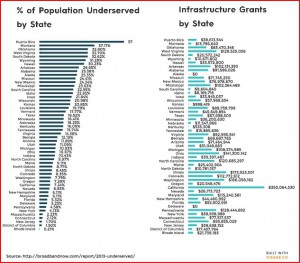 The Dude was knee deep in working on a rant, er, rather, an informative post, about pie charts when he came down sick with a nasty head cold and allergy attack. It seems like the kind that a few expired Allegra poppers might not immediately eradicate, so it’s on to Plan B, which for this week is remote desktop access courtesy of the NLC CompTeam (thanks, CompTeam) and a short tidbit on broadband (now defined by the FCC as 25 Mbps downstream) and underserved areas. As a part of this report, FCC Commissioner Jessica Rosenworcel said: “We can do audacious things if we set big goals, and I think our new threshold, frankly, should be 100Mbps.” Good progressive thinking, Jessica.
The Dude was knee deep in working on a rant, er, rather, an informative post, about pie charts when he came down sick with a nasty head cold and allergy attack. It seems like the kind that a few expired Allegra poppers might not immediately eradicate, so it’s on to Plan B, which for this week is remote desktop access courtesy of the NLC CompTeam (thanks, CompTeam) and a short tidbit on broadband (now defined by the FCC as 25 Mbps downstream) and underserved areas. As a part of this report, FCC Commissioner Jessica Rosenworcel said: “We can do audacious things if we set big goals, and I think our new threshold, frankly, should be 100Mbps.” Good progressive thinking, Jessica.
While it is axiomatic that libraries play a huge role in bridging the underserved gap (especially in smaller communities), how does Nebraska rate as far as underserved areas (and infrastructure grants)? Well, you could try to decipher the massive bar chart above, or look at this simple graphic I created (you might have to click to enlarge):
Shaka.
Posted in General, Library Management, Technology, Uncategorized
1 Comment

